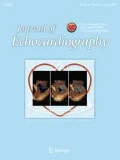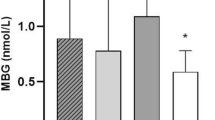Abstract
Background
Indoxyl sulfate (IS), a uremic toxin, has been reported to have hypertrophic effects on the heart. Previous studies, however, have shown no association between elevated IS levels and cardiovascular outcomes in hemodialysis patients. We hypothesized that, despite left ventricular (LV) hypertrophy, myocardial contractility and ventricular–arterial coupling would remain preserved, and that this would explain the reason for the absence of prognostic impact of IS.
Methods
We evaluated the association of IS with LV structure, contractility, vascular function, and mechanical efficiency (ventricular–arterial coupling and stroke work/pressure volume area) in 154 patients on hemodialysis, using echocardiography-based pressure–volume loop assessment.
Results
As expected, subjects in the high IS group (IS ≥ 33.8 μg/mL) had greater LV mass index and end-diastolic volume index compared to subjects in the low IS group (IS < 33.8 μg/mL). These differences remained significant after adjusting for age, sex, body mass index, diabetic nephropathy, duration of hemodialysis, and NT-proBNP levels, suggesting a potential role of elevated IS levels in LV remodeling. However, no differences in LV contractility (preload recruitable stroke work, peak power index, and systolic mitral annular velocity) and mechanical efficiency (ventricular–arterial coupling and stroke work/pressure volume area) were observed between the groups.
Conclusions
Deleterious effects of IS on LV remodeling are not accompanied by impaired LV contractility or mechanical efficiency, which could contribute to the absence of cardiovascular prognostic impact observed in previous studies performed on hemodialysis patients.



Similar content being viewed by others
References
USRDS. Annual data report 2017: international comparisons. 2017. Available at: https://www.usrds.org/2017/view/v2_11.aspx. Accessed 6 July 2018.
National Institute of Diabetes and Digestive and Kidney Diseases. Kidney disease statistics for the United States. Available at: https://www.niddk.nih.gov/health-information/health-statistics/kidney-disease. Accessed 6 July 2018.
The Japanese Society for Dialysis Therapy. 2016 statistics of maintenance Dialysis therapy in Japan. 2016. Available at: http://docs.jsdt.or.jp/overview/pdf2017/p004.pdf. Accessed 6 July 2018.
Foley RN, Collins AJ. End-stage renal disease in the United States: an update from the United States renal data system. J Am Soc Nephrol. 2007;18:2644–8.
Hung SC, Kuo KL, Wu CC, et al. Indoxyl sulfate: A novel cardiovascular risk factor in chronic kidney disease. J Am Heart Assoc. 2017;6:e005022.
Barreto FC, Barreto DV, Liabeuf S, et al. Serum indoxyl sulfate is associated with vascular disease and mortality in chronic kidney disease patients. Clin J Am Soc Nephrol. 2009;4:1551–8.
Lekawanvijit S, Adrahtas A, Kelly DJ, et al. Does indoxyl sulfate, a uraemic toxin, have direct effects on cardiac fibroblasts and myocytes? Eur Heart J. 2010;31:1771–9.
Lekawanvijit S, Kompa AR, Manabe M, et al. Chronic kidney disease-induced cardiac fibrosis is ameliorated by reducing circulating levels of a non-dialysable uremic toxin, indoxyl sulfate. PLoS One. 2012;7:e41281.
Shimazu S, Hirashiki A, Okumura T, et al. Association between indoxyl sulfate and cardiac dysfunction and prognosis in patients with dilated cardiomyopathy. Circ J. 2013;77:390–6.
Sato B, Yoshikawa D, Ishii H, et al. Relation of plasma indoxyl sulfate levels and estimated glomerular filtration rate to left ventricular diastolic dysfunction. Am J Cardiol. 2013;111:712–6.
Obokata M, Sunaga H, Ishida H, et al. Independent and incremental prognostic value of novel cardiac biomarkers in chronic hemodialysis patients. Am Heart J. 2016;179:29–41.
Lin CJ, Wu CJ, Pan CF, et al. Serum protein-bound uraemic toxins and clinical outcomes in haemodialysis patients. Nephrol Dial Transplant. 2010;25:3693–700.
Wu IW, Hsu KH, Hsu HJ, et al. Serum free p-cresyl sulfate levels predict cardiovascular and all-cause mortality in elderly hemodialysis patients–a prospective cohort study. Nephrol Dial Transplant. 2012;27:1169–75.
Lin CJ, Wu V, Wu PC, et al. Meta-analysis of the associations of p-Cresyl sulfate (PCS) and Indoxyl Sulfate (IS) with cardiovascular events and all-cause mortality in patients with chronic renal failure. PLoS One. 2015;10:e0132589.
Borlaug BA, Lam CS, Roger VL, et al. Contractility and ventricular systolic stiffening in hypertensive heart disease insights into the pathogenesis of heart failure with preserved ejection fraction. J Am Coll Cardiol. 2009;54:410–8.
Obokata M, Kurosawa K, Ishida H, et al. Incremental Prognostic value of Ventricular–Arterial coupling over ejection fraction in patients with maintenance hemodialysis. J Am Soc Echocardiogr. 2017;30(444–453):e2.
Obokata M, Negishi K, Marwick TH, et al. Comparison of different interdialytic intervals among hemodialysis patients on their echocardiogram-based cardiovascular parameters. Am Heart J. 2015;169(523–30):e2.
Borlaug BA, Olson TP, Lam CS, et al. Global cardiovascular reserve dysfunction in heart failure with preserved ejection fraction. J Am Coll Cardiol. 2010;56:845–54.
Lang RM, Badano LP, Mor-Avi V, et al. Recommendations for cardiac chamber quantification by echocardiography in adults: an update from the American society of echocardiography and the European association of cardiovascular imaging. J Am Soc Echocardiogr. 2015;28(1–39):e14.
Chen CH, Fetics B, Nevo E, et al. Noninvasive single-beat determination of left ventricular end-systolic elastance in humans. J Am Coll Cardiol. 2001;38:2028–34.
Saiki H, Eidem BW, Ohtani T, et al. Ventricular–arterial function and coupling in the adult fontan circulation. J Am Heart Assoc. 2016;5:e003887.
Borlaug BA, Kass DA. Ventricular-vascular interaction in heart failure. Heart Fail Clin. 2008;4:23–36.
Suga H. Ventricular energetics. Physiol Rev. 1990;70:247–77.
Takaoka H, Takeuchi M, Odake M, et al. Comparison of hemodynamic determinants for myocardial oxygen consumption under different contractile states in human ventricle. Circulation. 1993;87:59–69.
Kawaguchi M, Hay I, Fetics B, et al. Combined ventricular systolic and arterial stiffening in patients with heart failure and preserved ejection fraction: implications for systolic and diastolic reserve limitations. Circulation. 2003;107:714–20.
Wanner C, Amann K, Shoji T. The heart and vascular system in dialysis. Lancet. 2016;388:276–84.
Cao XS, Chen J, Zou JZ, et al. Association of indoxyl sulfate with heart failure among patients on hemodialysis. Clin J Am Soc Nephrol. 2015;10:111–9.
Fujii H, Nishijima F, Goto S, et al. Oral charcoal adsorbent (AST-120) prevents progression of cardiac damage in chronic kidney disease through suppression of oxidative stress. Nephrol Dial Transplant. 2009;24:2089–95.
Lin CY, Hsu YJ, Hsu SC, et al. CB1 cannabinoid receptor antagonist attenuates left ventricular hypertrophy and Akt-mediated cardiac fibrosis in experimental uremia. J Mol Cell Cardiol. 2015;85:249–61.
de Simone G, Devereux RB, Koren MJ, et al. Midwall left ventricular mechanics. An independent predictor of cardiovascular risk in arterial hypertension. Circulation. 1996;93:259–65.
Hensen LCR, Goossens K, Delgado V, et al. Prognostic Implications of Left Ventricular Global Longitudinal Strain in Predialysis and Dialysis Patients. Am J Cardiol. 2017;120:500–4.
de Simone G, Devereux RB, Roman MJ, et al. Assessment of left ventricular function by the midwall fractional shortening/end-systolic stress relation in human hypertension. J Am Coll Cardiol. 1994;23:1444–51.
Aurigemma GP, Silver KH, Priest MA, et al. Geometric changes allow normal ejection fraction despite depressed myocardial shortening in hypertensive left ventricular hypertrophy. J Am Coll Cardiol. 1995;26:195–202.
Dou L, Jourde-Chiche N, Faure V, et al. The uremic solute indoxyl sulfate induces oxidative stress in endothelial cells. J Thromb Haemost. 2007;5:1302–8.
Yamamoto H, Tsuruoka S, Ioka T, et al. Indoxyl sulfate stimulates proliferation of rat vascular smooth muscle cells. Kidney Int. 2006;69:1780–5.
Ky B, French B, May Khan A, et al. Ventricular–arterial coupling, remodeling, and prognosis in chronic heart failure. J Am Coll Cardiol. 2013;62:1165–72.
Hansson NH, Sorensen J, Harms HJ, et al. Myocardial oxygen consumption and efficiency in aortic valve stenosis patients with and without heart failure. J Am Heart Assoc. 2017;6:e004810.
Author information
Authors and Affiliations
Corresponding author
Ethics declarations
Conflict of interest
Dr. Obokata received research funding from Kureha Corporation, Tokyo, Japan. The sponsor was not involved in the study design, data collection, analysis and interpretation, and preparation of manuscript. Dr. Negishi was supported by an award from the Select Foundation, which has no role in the preparation of this manuscript. Drs. Kurosawa, Ishida, Ito, Ogawa, Ando, and Kurabayashi declare that they have no conflict of interest.
Ethical approval
All procedures followed were in accordance with the ethical standards of the responsible committee on human experimentation (institutional and national) and with the Helsinki Declaration of 1964 and later revisions.
Informed consent
Informed consent was obtained from all patients for being included in the study.
Rights and permissions
About this article
Cite this article
Obokata, M., Kurosawa, K., Ishida, H. et al. Echocardiography-based pressure–volume loop assessment in the evaluation for the effects of indoxyl sulfate on cardiovascular function. J Echocardiogr 17, 35–43 (2019). https://doi.org/10.1007/s12574-018-0385-5
Received:
Revised:
Accepted:
Published:
Issue Date:
DOI: https://doi.org/10.1007/s12574-018-0385-5




